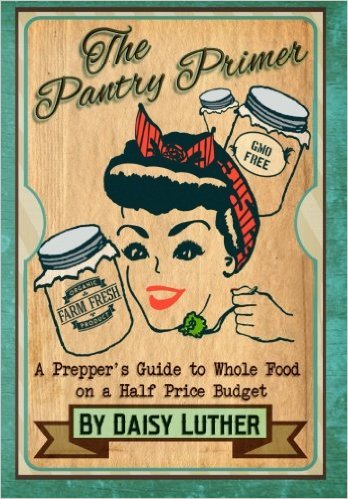If you're new here, you may want to subscribe to my RSS feed. Thanks for visiting!
One area in which many pantries are lacking is protein. Because meat is so perishable (and also expensive) it is often the most neglected frontier of the one-year pantry.
This is a vital addition to your pantry, because without proper protein, hard-working muscles cannot heal and strengthen. Particularly in a disaster situation, you may be called upon to perform much harder physical labor than you are accustomed to. It is a necessity to provide your body with the building blocks it needs to repair itself and become stronger. Tess Pennington writes:
Being well-nourished during a disaster can mean the difference between powering through the event with strength, stamina and energy or plodding through the situation barely able to put one foot in front of the other.
One often overlooked component of the prepper’s pantry is protein. This vital nutrient:
- Helps with the repair and building of muscle tissue
- Helps the body heal from injuries
- Provides long-lasting stamina
- Helps boost the immune system
Protein is stored throughout the body. It can be found in muscles, bones, hemoglobin, myoglobin, hormones, antibodies, and enzymes. In fact, protein makes up nearly 45% of the human body. Without a steady supply, body functions will cease to operate effectively. (source)
You don’t have to be relegated to those nasty cans of minced up chicken parts or tins of Fukushima-flavored fish. There are several strategies you can use to stockpile protein and still feed your family healthy food during rough times.
Go vegetarian
You don’t have to go totally vegetarian to use this strategy, but you can enjoy some meatless meals to stretch your budget and extend your meat supply. Add the following healthy vegetarian protein sources to your pantry:
- Dried beans: When well-packed, dried beans can last up to -10 years. Beans can also be sprouted to provide a quick source of fresh veggies in a longer-term emergency.
- Canned beans: Some emergencies mean that your normal means of cooking may not be available. If the power grid is down, canned beans (whether purchased at the store or home-canned) will provide instant protein in the blink of an eye.
- Quinoa: The ancient Incas called quinoa the “mother of all grains” for a reason. This little grain is a nutritional powerhouse and contains 8 grams of protein per cup. If you aren’t familiar with quinoa, you can learn more about it HERE.
- Nuts and nut butters: Shelf life for nut products is shorter because the fats can go rancid – plan for about a one-year shelf life.
- Protein powder: These can be highly processed and contain toxic ingredients like artificial sweeteners. Do your research and select carefully. Unflavored protein powders can be added to savory dishes for a boost of muscle-building nutrients.
- Texturized vegetable protein: I hesitated before including this because more than 80% of the soy sold in North America is genetically modified. Only purchase ORGANIC TVP if you wish to avoid GMOs, which can be deadly.
Purchase in quantity
When purchasing meat in quantity, you want to treat it as an investment. Take the time to locate a source that you can trust. Consider small butcher shops or local farms, and find out how the animals were farmed, keeping the above tips in mind.
One of the best ways to lessen the price of good quality meat is to purchase it in quantity. When you purchase a side or quarter of beef or pork, you can reduce the price per pound dramatically. As well, the butcher will cut it up in the way that you prefer. You can opt for stewing beef over ground beef, for example, with the lesser cuts of meat.
Making friends with your butcher or farmer could also put you at the front of the line for meats that they’d like to get rid of before they expire. I recently acquired 5 whole chickens at half price from a local farmer because I was able to take them immediately. Other ways to get in the loop on these good deals are through internet sources like Craigslist and private groups on Facebook or other social media networks.
Learn how to preserve meat
Before you stash that side of beef in the deep freeze, consider the vulnerability of the electrical grid. We have recently heard many warnings telling us that our access to electrical power could disappear at the blink of an eye. You could sustain massive losses to your food supply if you are reliant on electricity to preserve such a large investment.
Consider the following ways to preserve meat for your pantry:
- Dehydration: Learn how to dehydrate ham, poultry and ground beef crumbles HERE. Remember that rehydration can use valuable water supplies.
- Making Jerky: You can easily make jerky in your dehydrator for an instant protein snack that does not require rehydration. Vacuum seal it to prolong the shelf life.
- Pemmican: A paste made from meat mixed with natural elements such as berries, roots, and herbs is then dried until it is hard and brittle. Learn how to make your own pemmican HERE.
- Curing/Smoking: These two methods are low-tech ways to preserve meat without the need for refrigeration. Check HERE and HERE for instructions.
- Canning: This is my personal favorite method of preserving meat. You can make soups or stews, or you can simply preserve meat to be used in recipes in the future. Dinner can be ready as quickly as popping open a jar and heating the contents. Here are instructions for roasts, turkey, ham, and chicken and recipes for meals in jars can be found HERE.
Make the investment
Use the strategies discussed in the Pantry Primer series to save up enough money to make a large investment in meat. Although it’s a lot of money initially, you will save substantially from the price of purchasing in small increments each week at the grocery store.
Want to learn more? My new book is now available!
Lots of us like to have hard copies of information that we’ve found helpful. Because of this, I’ve expanded on the information included in this series and put it all in one handy primer, available on Amazon.
The Pantry Primer: How to Build a Whole Food Pantry on a Half Price Budget

















10 Responses
Salted Cod can be purchased from Portuguese, Italian, or sometimes regular grocery stores. It is expensive, but is worth adding to the “larder.” I was not raised with this food option, but tried it and really like it.
Is salt pork a possibility?
I was actually thinking about this today. One concern I have about beans (and peanuts, too) is that they contain phytates which may impair mineral absorption, unless they are properly soaked, which I do not think occurs in cans. I am still leaning more towards the fish in Atlantic waters and shellfish. That being said, I love Sockeye salmon and am still buying cans of those. Perhaps stocking up on nuri could minimize any Fukashina exposure.
We bought 50# bags of whey for additional protein in our smoothie drinks.
Good article and timely. I pressure cann all of the meats I have stored; Beef, Chicken, Pork Loin, Ham, Turkey, Tuna – even bacon and hot dogs. At last inventory I had over a 1,000 pounds canned and in storage. I am eating stuff I canned in 2008 now and replenish as I use it. Meat in a glass jar will last a LONG time and it is not even hard to process. And you are correct about buying in bulk; I get Beef Top Round from my local restaurant supply store in 30 pound chunks…
Whenever we can meat, we raw pack it. The only thing that we add is 1/4 teaspoon Himalayan salt to each pint jar.
The meat, whether it is beef, pork or chicken, has more that enough liquid in it for the canning. Sometimes it might look a little ugly in the jar, but it sure tastes good!
Bob
III
Greetings:
Wonderful article as always. We started a meat buying club that I think would help everyone who reads this blog.
Buy a 1/2 an organic grass fed cow, sell the choice bits (talk to your butcher to figure that out!) and you end up with a lot of free ground, stewing and flank steaks from what I’ve found. It was easy to do where I live? You just need to focus on premium meat buyers and sell them cuts at less then they would pay at the grocery store. Some people bid (since the meat we bring in is better then the butchers around here!) on cuts…
A chateaubriand we sold once was worth 1/5th of the whole side!
I am not sure if this has been addressed anywhere, and Google fails me. Pasta canning. Can it be done safely? I like to make my own ravioli, but it’s such a process I make a huge batch, frequently with different fillings. We’ve been freezing it uncooked, but if the grid goes down, I lose all that hard work AND delicious food. Can things like ravioli be pressure canned safely and effectively? A little mushy isn’t a deal breaker. Botulism is! Do you (or anyone!) have experience or wisdom to offer?
Hi, Anonna:
I personally have not had great luck with canning pasta because of the mushiness. Ravioli could be different, but I had horrible results when I tried chicken noodle soup. It was complete mush – not just a little mushy. What I’d recommend is that you experiment by canning just ONE JAR of ravioli when you are canning other things – that way if it is a failed experiment, you don’t waste an entire batch.
Happy canning ~
Daisy
i buy smoked herring from germany.its a brand called ruggenfisch.it is simply an amazing high quality protein source. i eat half a can a day which is only 25% sodium intake for a day. also, whole grain tahini is an amazing and cheap protein source and can be used in a myriad of ways. most tahini (the whiter stuff) is not quite as good as the whole grain which is a darker brown. look in big city ethnic stores for the whole grain tahini.it seems to come out of greece.
peace
I’m having difficulty sending this excellent article to my E-mail account, where I can read it later. It seems you have to “sign in” with one of several info-intrusive services. Would someone out there in computer-land be so kind as to send me a copy of this excellent article (“Building protein”) to my E-mail? Thank you very much. ([email protected])